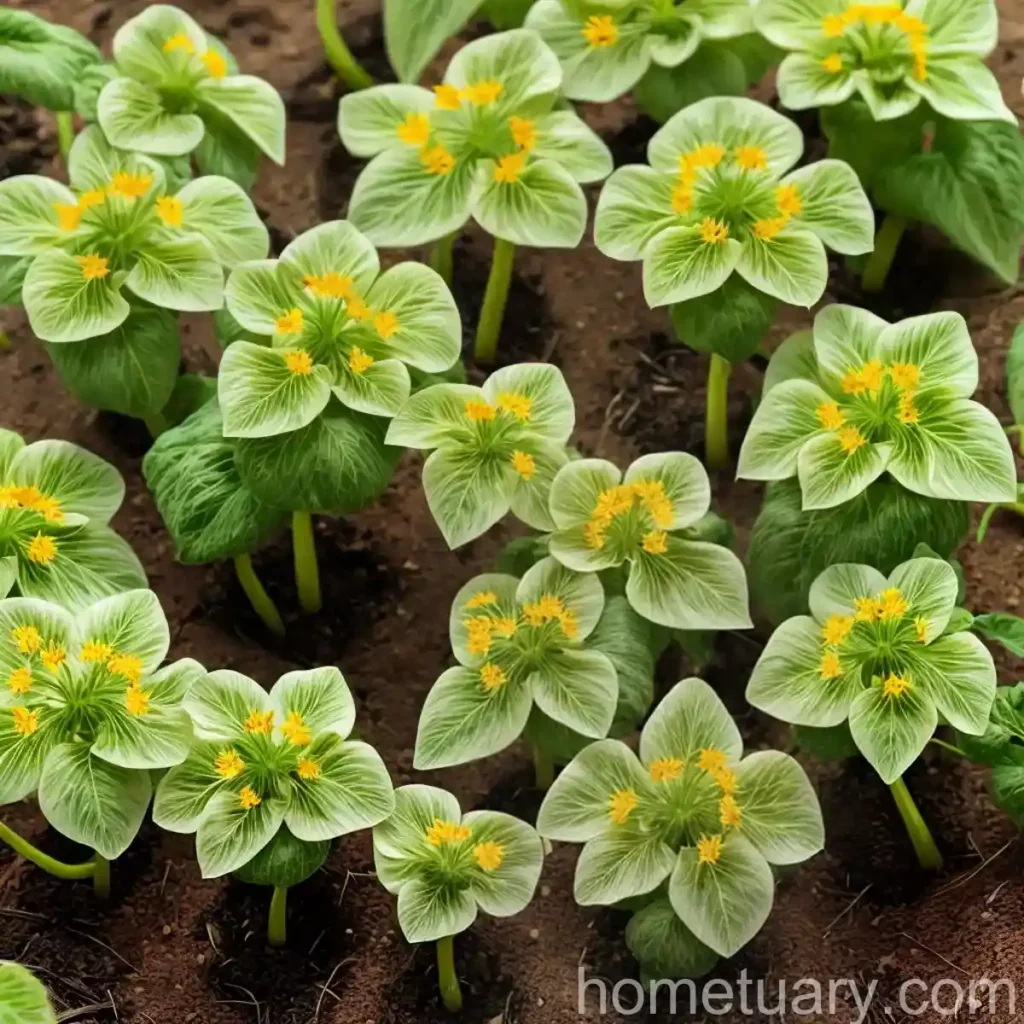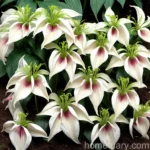The Wonderful World of Goosefoot (Arrowhead) Plant (Syngonium podophyllum)
The Goosefoot plant, scientifically known as Syngonium podophyllum, is a versatile and attractive plant that has gained popularity among plant enthusiasts due to its ease of care and decorative allure. Also commonly referred to as the Arrowhead plant, this species belongs to the family Araceae and is native to Latin America. With its unique leaf shapes, various color patterns, and air-purifying qualities, the Goosefoot plant has become a common sight in homes and offices around the world.
In this comprehensive guide, we will delve into every aspect of the Goosefoot plant, from its cultural requirements to propagation techniques, common diseases, and pests. We will also touch upon the aesthetic appeal and popularity of this plant, along with botanist’s tips, fun facts, and links to external resources. Whether you are a novice plant parent or an experienced green thumb, this guide will equip you with all the knowledge needed to nurture and appreciate the beauty of the Syngonium podophyllum.
What is the Goosefoot (Arrowhead) Plant (Syngonium podophyllum)?
Syngonium podophyllum, commonly known as Goosefoot or Arrowhead plant, is a tropical evergreen vine that is widely cultivated as a houseplant. It is cherished for its arrow-shaped leaves and its ability to thrive in various conditions, making it a popular choice for indoor environments. The leaves of the Syngonium podophyllum plant display an array of colors and variegation, adding a touch of elegance to any living space.
Key Takeaways – Goosefoot (Arrowhead) Plant (Syngonium podophyllum)
Before we delve into the specifics of caring for the Goosefoot plant, let’s highlight the key takeaways of this unique species:
- Scientific Name: Syngonium podophyllum
- Common Names: Arrowhead plant, Goosefoot plant
- Family: Araceae
- Native Habitat: Latin America
- Key Features: Arrow-shaped leaves, variegated patterns, air-purifying
- Popularity: Widely grown as a houseplant
- Care Level: Easy to moderate
- Propagating Methods: Stem cuttings, division
- Toxicity: Considered toxic to humans and pets if ingested
- Cultural Requirements: Requires moderate water, indirect sunlight, well-draining soil
Now that we have a brief overview of the Goosefoot plant, let’s explore the cultural aspects, uses, and care guidelines for this captivating species.
Culture
Uses
The Goosefoot plant holds various uses, from its ornamental value to its air-purifying properties. Some of the primary uses of Syngonium podophyllum include:
- Indoor Decoration: Its attractive foliage makes it a popular choice for indoor decor, adding a touch of greenery to homes, offices, and public spaces.
- Air Purification: Like many other houseplants, the Goosefoot plant contributes to improving indoor air quality by removing pollutants and increasing oxygen levels.
- Feng Shui: In the practice of Feng Shui, the Syngonium podophyllum is believed to attract positive energy and prosperity when placed in specific areas of the home or workplace.
Water
Proper watering is essential for the health and vitality of the Goosefoot plant. As with most houseplants, overwatering can lead to root rot, while underwatering can cause wilting and leaf damage. Finding the right balance is crucial to maintaining a thriving Syngonium podophyllum.
Watering Tips:
– Water thoroughly, allowing excess water to drain from the bottom of the pot.
– Allow the top inch of the soil to dry out before watering again.
– Adjust watering frequency based on seasonal changes and the plant’s growth stage.
Sunlight
Light Requirements
The Syngonium podophyllum thrives in bright, indirect light. This means placing it near a window where it can receive ample natural light without being exposed to direct sunlight, which can scorch its delicate leaves. Inadequate light may result in stunted growth and a reduction in variegation.
Sunlight Tips:
– Position the plant near a north or east-facing window to provide the ideal balance of light.
– Rotate the plant occasionally to ensure uniform growth and prevent excessive leaning towards the light source.
Fertilizer
Feeding the Goosefoot plant with a balanced houseplant fertilizer can promote healthy growth and vibrant foliage. During the growing season, which typically spans from spring to summer, regular fertilization can provide the necessary nutrients for the Syngonium podophyllum to flourish.
Fertilizer Guidelines:
– Use a diluted, balanced liquid fertilizer every 2-4 weeks during the growing season.
– Refrain from fertilizing during the winter months when the plant is in a dormant phase.
Soil
Potting Mix
A well-draining potting mix is crucial for the Goosefoot plant, as it helps prevent waterlogged conditions that can lead to root rot. A mix that retains some moisture while allowing excess water to drain away is ideal for promoting healthy root development and overall plant vigor.
Recommended Potting Mix:
– Use a blend of peat moss, perlite, and coarse sand for a well-aerated and moisture-retentive soil mix.
– Consider adding organic matter to improve the soil structure and provide essential nutrients.
Pruning
Pruning plays a key role in shaping and managing the growth of the Syngonium podophyllum. Regular maintenance helps prevent leggy growth and maintains the plant’s desired appearance. Pruning also allows for the removal of damaged or yellowing leaves, promoting overall plant health.
Pruning Tips:
– Use clean, sharp scissors or pruning shears to remove unwanted growth, such as leggy stems or damaged leaves.
– Prune selectively to maintain the desired shape and size of the plant, encouraging bushier and more compact growth.
Propagation
Methods
Propagating the Goosefoot plant is relatively straightforward and can be accomplished through various methods, including stem cuttings and division. These propagation techniques allow plant enthusiasts to expand their collection or share the beauty of the Syngonium podophyllum with others.
Propagating Tips:
– Select healthy stems with several nodes for stem cuttings, ensuring they are free from diseases or pests.
– Ensure the use of clean, sharp tools when taking cuttings or dividing the plant to minimize the risk of infections.
Container Popularity
The Goosefoot plant is often favored for container gardening due to its adaptability to indoor environments and its ability to thrive in confined spaces. In addition to standard pots and planters, the Syngonium podophyllum can be showcased in hanging baskets or terrariums, adding charm to any setting.
Container Ideas:
– Display the Arrowhead plant in decorative pots that complement its leaf colors and patterns, enhancing its visual appeal.
– Experiment with different container types, such as hanging baskets or wall-mounted planters, to create unique and attractive displays.
Common Diseases
Disease Diagnosis
Despite being a relatively resilient houseplant, the Goosefoot plant is susceptible to certain diseases, most of which are attributed to improper care or environmental stress. Recognizing the symptoms and addressing them promptly is critical for preventing the spread of diseases and preserving the health of the Syngonium podophyllum.
Common Diseases:
– Root Rot: Caused by overwatering or poorly-draining soil, leading to wilting, yellowing of leaves, and a foul odor from the root system.
– Leaf Spot: Characterized by dark spots or lesions on the leaves, often caused by overwatering, poor air circulation, or high humidity.
– Botrytis Blight: A fungal disease that may occur in humid or poorly ventilated conditions, resulting in brown or black spots on the leaves.
Common Pests
Pest Control
Pests can pose a threat to the health and appearance of the Goosefoot plant if left unaddressed. Common insects such as spider mites, aphids, and mealybugs may target the Syngonium podophyllum, causing damage to the foliage and diminishing its overall vitality.
Pest Management:
– Regularly inspect the plant for signs of pests, including webbing, stippling on leaves, or the presence of insects.
– Employ natural pest control methods, such as neem oil or insecticidal soap, to deter and eliminate common pests without harming the plant.
Botanist’s Tips
As a plant scientist with a passion for the Syngonium podophyllum, I have gathered valuable insights and tips for enthusiasts seeking to cultivate and appreciate this remarkable species. Here are some botanist’s tips for caring for the Goosefoot plant:
- Variegated Varieties: Embrace the diversity of Arrowhead plant varieties with variegated leaves, each displaying unique patterns and colors.
- Humidity Preferences: Maintain moderate humidity levels to support healthy growth, especially for variegated varieties that may benefit from slightly higher humidity.
- Training Vines: Guide the growth of Syngonium podophyllum vines, either with a small trellis or by gently wrapping them around supports for an elegant trailing appearance.
Fun Facts
Let’s explore some fun and interesting facts about the Goosefoot (Arrowhead) plant:
- The Syngonium podophyllum is named for its foliage, which resembles the shape of a goose’s foot.
- Some cultivars of the Arrowhead plant showcase striking pink or red hues in their new leaf growth.
- The Syngonium podophyllum is a known air purifier, helping to remove volatile organic compounds (VOCs) from indoor environments.
Links to External Resources
To further expand your knowledge and appreciation for the Goosefoot (Arrowhead) plant, consider exploring the following external resources:
- Syngonium Podophyllum Care Guide – The Sill
- Arrowhead Plant: A Complete Guide to Growing Syngonium
- Houseplants for a Healthy Home – NASA’s Guide to Air-Filtering Plants
In conclusion, the Goosefoot (Arrowhead) plant, or Syngonium podophyllum, offers a delightful blend of aesthetics and ease of care, making it a cherished addition to any indoor space. With its distinctive foliage, air-purifying qualities, and versatility, this tropical gem continues to capture the hearts of plant enthusiasts worldwide. Whether adorning a shelf, hanging gracefully in a basket, or prospering in a terrarium, the Syngonium podophyllum stands as a testament to the beauty and resilience of nature’s botanical wonders.















